Diffraction Instruments
The ILL's diffraction instruments are divided into two main groups:
powder diffractometers
and
single-crystal diffractometers.
In this page you will find a very short description of our instruments.
If you
are interested in more detailed information, you can follow
the link
 for the corresponding
Yellow Book entry (mantained by the SCO) or
for the corresponding
Yellow Book entry (mantained by the SCO) or
the link
 for the official page of the instrument (mantained by each Instrument Scientist).
for the official page of the instrument (mantained by each Instrument Scientist).
 Powder diffractometers
Powder diffractometers
| | 
|
D1A
high-resolution two-axis diffractometer
|

|

|
| | 
|
D2B
high-resolution two-axis diffractometer
|

|

|
| | 
|
D1B
two-axis diffractometer
|

|

|
| | 
|
D20
high intensity two-axis diffractometer with variable resolution
|

|

|
| | 
|
D4
liquids and amorphous diffractometer
|

|

|
| | 
|
SALSA
strain analyser for engineering applications
|

|

|
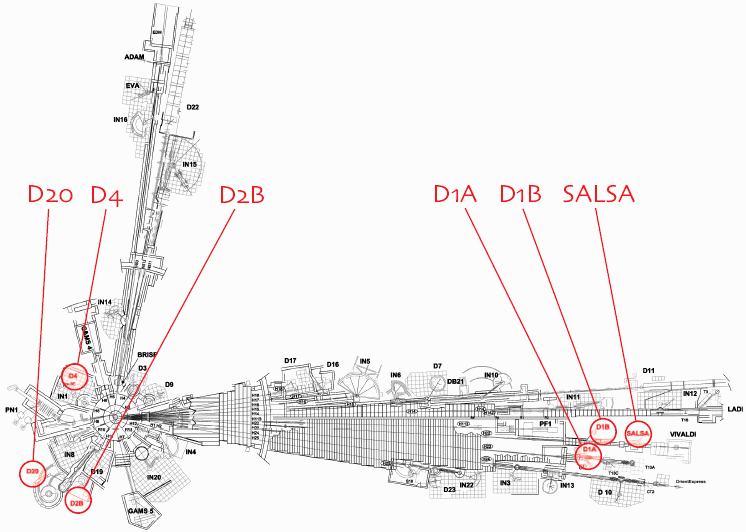 |
 Single-crystal diffractometers
Single-crystal diffractometers
|

|
| | 
|
D3
polarised hot neutron diffractometer
|

|

|
| | 
|
D9
hot neutron 4-circle diffractometer
|

|

|
| | 
|
D10
thermal neutron 4-circle & three-axis diffractometer
|

|

|
| | 
|
D15
thermal neutron normal-beam diffractometer
|

|

|
| | 
|
D19
4-circle diffractometer with 2D PSD for large unit cells
|

|

|
| | 
|
D23
thermal neutron normal-beam diffractometer + polarised neutron option
|

|

|
| | 
|
VIVALDI
thermal beam Laue diffractometer
|

|

|
| | 
|
ORIENT EXPRESS
new thermal beam Laue diffractometer
|
|

|
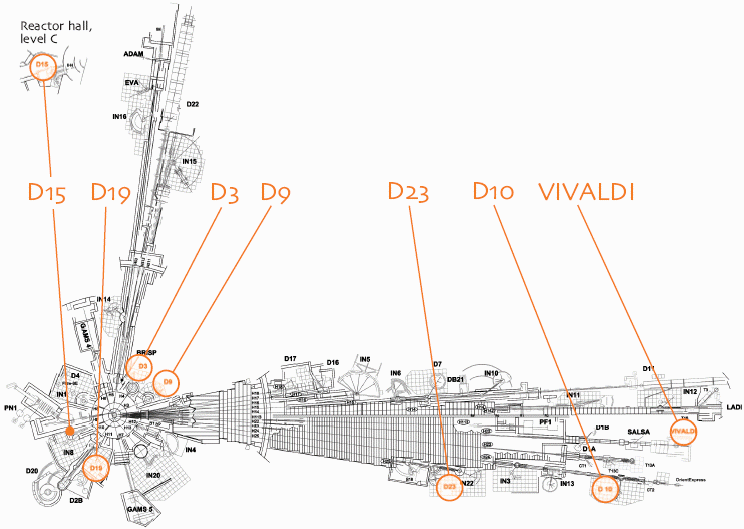 |
Powder diffractometers
These two-axis diffractometers are used to investigate the structure of
powders, liquids and amorphous materials. Diffraction group machines
use relatively short wavelength neutrons (0.3 to 2.0 Å) to resolve structures
to atomic resolution, in contrast to diffractometers in the Large
Scale Structures group that use long wavelength neutrons for lower resolution
of larger structures. Usually a large composite monochromator, up
to 300 mm high, is used to select a narrow band of wavelengths and focus
it onto the sample.The monochromator may be made from several crystals
of pyrolytic graphite, copper or germanium. Large multi-detectors and
linear position-sensitive detectors (PSDs) cover a large solid angle for
maximum efficiency.
The two high-resolution powder diffractometers D1A and D2B are used
mainly for Rietveld refinement, with scans lasting from 30 minutes to several
hours. They are complemented by two high-flux medium-resolution
powder machines, D1B and D20, which are used mainly for temperature
scans and other types of fast experiment, especially on small samples. D4,
on the short wavelength hot source, is used for liquids and amorphous
materials, together with D20.
High-resolution two-axis diffractometer D1A
|

|
|
D1A is still unique in being able to provide high resolution at long wavelengths,
with shorter wavelength contamination eliminated by the guide
tube. D1A is particularly suited to magnetic structures and other large dspacing
studies, such as zeolites. D1A-stress provides very high lateral
resolution, and allows stress determination to within as little as 50 mm of
a surface or interface.
|
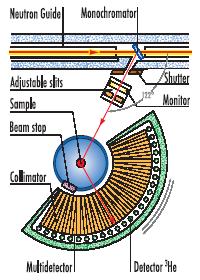
| 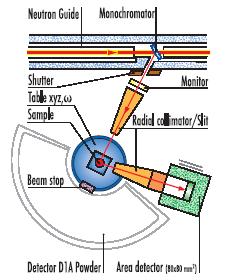
|
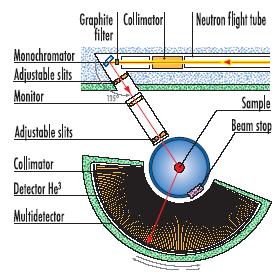
|
Very high-resolution two-axis diffractometer D2B
|

|
|
D2B was designed to achieve the ultimate resolution, limited only by
powder particle size (Δd/d ~ 5 x 10-4), but was built so that an alternative
high flux option, with resolution comparable to that of D1A but much
higher intensity, could be chosen at the touch of a button. D2B then has
very high intensity at D1A resolution, or very high resolution at D1A
intensity. Being on a beam tube in the reactor hall, it can use wavelengths
as short as 1.05 Å, impossible on D1A. The D2B detector bank was
recently replaced by a pseudo-2D detector with 6 times the solid angle,
and data can now be collected on samples as small as 500 milligrams in a
few hours, or normal samples of a few grams in a few minutes.
|
Two-axis diffractometer D1B
D1B has always been in very high demand for real time experiments, and
for very small samples because of its high efficiency position sensitive
detector (PSD). Although it is a CRG instrument, (run by a CNRS team
and Spain), it is available 50% of the time for scheduled ILL experiments.
Complete diffraction patterns covering 80° at moderate resolution can be
collected in a few minutes.
|
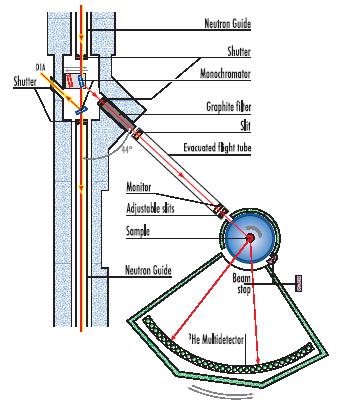
|

|
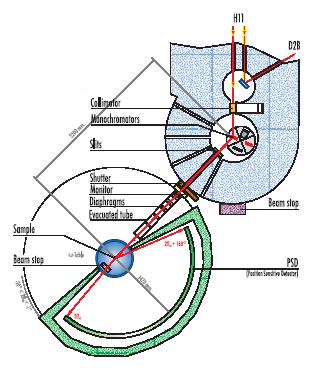
|
High-intensity two-axis diffractometer D20
|

| |
D20 has extremely high flux with a very large PSD and opens up new
possibilities for real-time experiments on very small samples. The complete
diffraction pattern at 1536 positions covering the whole scattering
range can be obtained in as little as a few hundred milliseconds (or more
typically a few seconds), and then repeated automatically as a function
of temperature, pressure, magnetic field, etc. Higher monochromator
take-off angles up to 120° provide good resolution over the complete
diffraction pattern, which can be obtained in a few minutes, even with
small samples.
|
Liquids and amorphous diffractometer D4
D4 on the hot source, is designed to use short wavelength neutrons to
measure diffraction patterns over a large Q-range from non-crystalline
materials (glasses, liquids, amorphous solids) with excellent accuracy and
to characterise their local atomic order. D4 shares a beam with the three-axis
spectrometer IN1 and is therefore only available for about 50 % of
the time. However the complete scattering range is covered by a large
array of microstrip detectors, making the machine very efficient and very
stable for different measurements on small samples, with isotopic replacement
used to enhance contrast of particular atomic species.
|
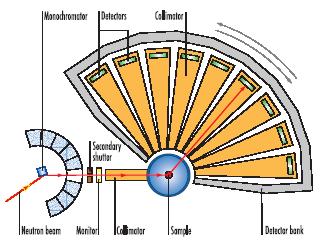
|

|
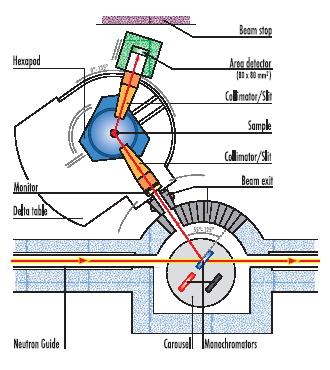
|
Strain analyser for large scale engineering applications SALSA
|

| |
SALSA is the new ILL strain imager dedicated to the determination of
residual stresses in a broad range of applications in terms of components
and materials. It is in fact designed for diffraction measurements in “real”
engineering components and optimised for stress determination in
metallic components.
|
Single-crystal diffractometers
Single-crystal diffraction is a powerful method for the investigation of
structural details in condensed matter. Hot neutrons are required to
uncover the finest details in the nuclear positions and neutron spin polarisation
is a handle to separate mixed components (nuclear polarisation,
magnetic and electronic scattering).
A characteristic of the four-circle diffractometers is the use of Eulerian
cradles for orienting the sample crystals, with the detector moving in a horizontal
plane. Normal-beam diffractometers have a mechanism for tilting the
counter out of the horizontal plane, thus enabling the installation of heavy
equipment for special crystal environments (cryostats, magnets, etc.).
These diffractometers can be used to find:
- average atomic positions. From these we can learn how the atoms are
bound together to form molecules, and how the molecules are stacked;
- local atomic distributions. This gives information about the time averaged
thermal motion or the local atomic disorder;
- magnetic structures and magnetic moment distributions.
Structural data of this kind are required for a large number of systems, ranging
from organic molecules to high temperature superconductors. Often
studies are made as a function of temperature, pressure and magnetic field
which may lead to important modifications of the crystal structure.
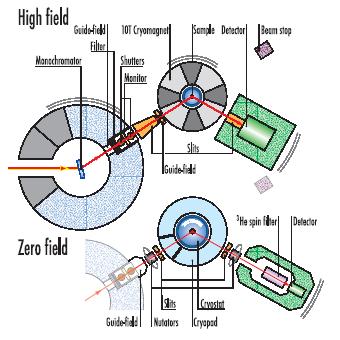
|
The spin polarised hot neutron beam facility D3
|

| |
D3 and D9 use neutrons from the hot source
with wavelengths as short as 0.3 Å.
It is therefore possible, using D3, to measure magnetic structure factors up
to sin θ/λ = 2 Å-1. D3 is a diffractometer with a polarised incident neutron
beam. In practice, the instrument is set at a Bragg peak of an already known
crystalline structure. Then, by simply reversing the beam polarisation, D3
performs a highly sensitive measurement of the spin-dependent nuclear
magnetic interference amplitude term which is present in the Bragg scattering
of polarised neutrons from a small single crystal specimen magnetised
in a field. With polarisation analysis and Cryopad, D3 carries out spherical
neutron polarimetry experiments. In the case of magnetic structures, this
leads to the direct determination of the magnetic interaction vector. Hence,
D3 is a very powerful tool for solving complex AF structures that had proven
to be intractable with other techniques. Moreover, when the magnetic
and nuclear scattering occurs at the same position in reciprocal space,
D3 allows a precise determination of the AF magnetisation distributions.
D3 can also be used for many purposes other than diffraction experiments,
e.g. the search for the T-odd asymmetry of light particle emission in 239Pu
ternary fission.
|
Hot neutron four-circle diffractometer D9
|

|
|
For structural analysis beyond the determination of average atomic positions,
high-resolution nuclear density maps are required. D9 is ideally
suited for this purpose. Because of the short wavelength very small
atomic displacements can be identified, accurate to typically 0.001 X.
A two-dimensional multidetector is employed.
Various models of anharmonicity are used, involving many parameters that
can only be determined by including reflections at high momentum transfers.
Structural data from D9 are also used:
- to help in the analysis of magnetic structures, especially if magnetic and
nuclear reflections are not superimposed as with antiferromagnets;
- for the determination of magnetic structures of absorbing elements as
Sm, Gd, etc;
- for various fundamental studies of the nature of diffraction from single
crystals;
- for combined neutron and X-ray analyses to get the electron distribution
in atoms and molecules;
- to get a model for the extinction correction by measuring at different
wavelengths.
|
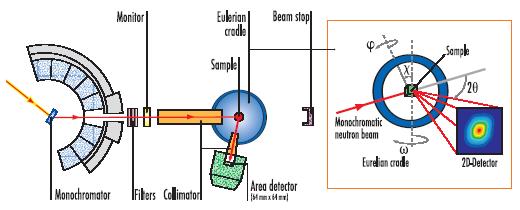
|
The three-axis diffractometer D10
D10 is unique in being the only four-circle diffractometer with optional
energy analysis as on three-axis spectrometers. It also possesses a unique
four-circle cryostat for temperatures as low as 0.1 K, and offers high reciprocal
space resolution and low intrinsic background, to medium real space
resolution.
It is intended primarily for conventional crystallography, detailed study of
modulated structures, quasielastic scattering and diffuse scattering.
|
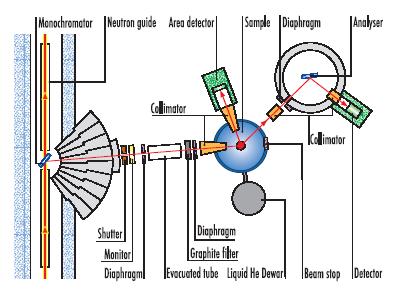
|

|
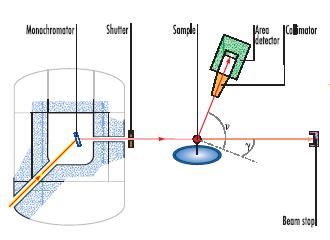
|
The two-axis diffractometer D15
|

|
D15 is a single-crystal diffractometer of the Harwell MK VI
design. It is installed on an inclined beam tube (IH4). To compensate for the
inclination of the incident beam, the scattering vector of the monochromator
is tilted to bring the monochromatic beam into the horizontal plane.
Three wavelengths can be set up (0.85 Å, 1.17 Å, and 1.54 Å) with corresponding
flux at the sample of 1.5 106, 7.8 106, and 3.0 106 n/s/cm2 respectively.
The instrument can be operated in either four-circle or normal-beam
mode. When a low background and higher efficiency are needed a monodetector
can be installed. Otherwise 80×80 mm2 bidimensional microstrip
detector is available.
|
The large structures diffractometer D19
D19, with its 120° × 30° position sensitive detector, is the monochromatic
thermal neutron single crystal/fibre diffractometer of choice for determination
of crystal structures with unit cells in the range of 103 to 105 Å3.
Examples of single crystal studies include organometallic complexes, proteins,
helium single crystals, acetylene polymers, liquid crystals,Vitamin B12,
cyclodextrin complexes. Fibre work includes studies of DNA, cellulose,
filamentous viruses and many industrial fibres.
|
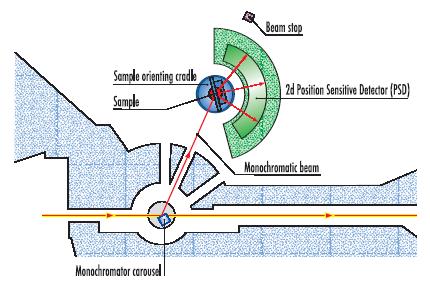
|

|
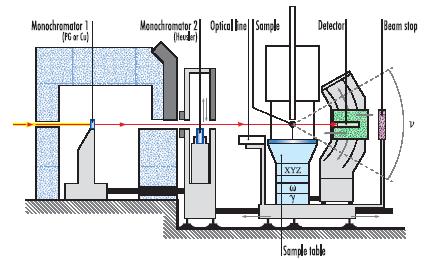
|
The two-axis diffractometer D23
|

| |
D23 is a double-monochromator two-axis diffractometer with a lifting
detector mounted on an arc (normal beam geometry). It is installed on the
thermal neutron guide H25 that is equipped with a supermirror-coating, and
thus offers a high flux and a very good signal to noise ratio. D23 is designed
to work with or without polarised neutrons, with wavelengths in the range
1 – 3 Å. It can support special sample environments (high field cryomagnets
up to 15 Tesla, pressure cells, dilution fridges, etc.) and is well suited to the
determination of magnetic structures, magnetic phase diagrams and magnetization
distribution maps.
|
The thermal beam Laue diffractometer VIVALDI
|

|
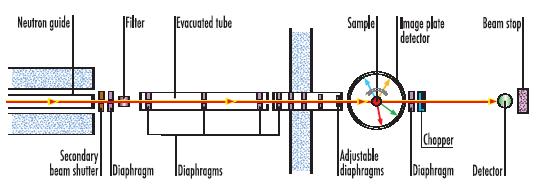
|
VIVALDI is Laue diffractometer using the same technique as LADI
(good-quality macromolecular diffraction
data rapidly obtained on a quasi-white cold-neutron
beam with a large-area cylindrical detector based on neutron image plates),
but on a thermal neutron beam and is very well suited to fast data collection
from the smaller unit cells of interest to physicists, chemists and materials
scientists.
VIVALDI covers fields of interest such as magnetism, charge (nuclear) density waves, highpressure
studies and structural phase transitions. It allows rapid preliminary investigation
of new materials, even when only small single crystals are available, and is particularly well
suited to surveys of reciprocal space.The detector is also suitable for some types of diffuse
scattering experiments on a monochromatic beam.
|
The new Laue diffractometer ORIENT EXPRESS
ORIENT EXPRESS allows Laue patterns to be taken at different
positions of the detector with respect to the incident beam.
Full back-reflection geometry (α = 180°) as in the case of the
film detector can be achieved but in much shorter time. The diffractometer
is composed of a two-dimensional detector mounted on a 2θ arm,
a two-stage tilt goniometer mounted on an ω rotation, and a video
system for the optical alignment of the crystal with respect to the incident
neutron beam. The diffractometer is located at the end of the thermal neutron
guide H24 at the guide hall ILL17.
|
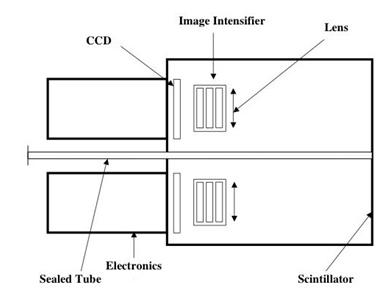
|

|


![]() for the corresponding
Yellow Book entry (mantained by the SCO) or
for the corresponding
Yellow Book entry (mantained by the SCO) or
![]() for the official page of the instrument (mantained by each Instrument Scientist).
for the official page of the instrument (mantained by each Instrument Scientist).

